Project HRM Plan for Ecological Wastewater Solutions (EWS) - PROJ6006
VerifiedAdded on 2022/09/22
|6
|998
|19
Project
AI Summary
This project outlines a leadership style and communication management plan for Ecological Wastewater Solutions (EWS), focusing on the expansion of the company into new markets. The plan addresses the importance of participative leadership, team balance (including MBTI assessments), and conflict resolution. It details a communication management plan using top-down, up-down, and horizontal communication strategies, leveraging various methods like emails, phone calls, and video conferencing. The project also includes a communication plan table outlining roles and responsibilities for human resources, team building, staff management, communication, and assessment. An improvement plan is proposed which includes reshuffling employees. The plan references various academic sources to support the strategies and methodologies proposed.
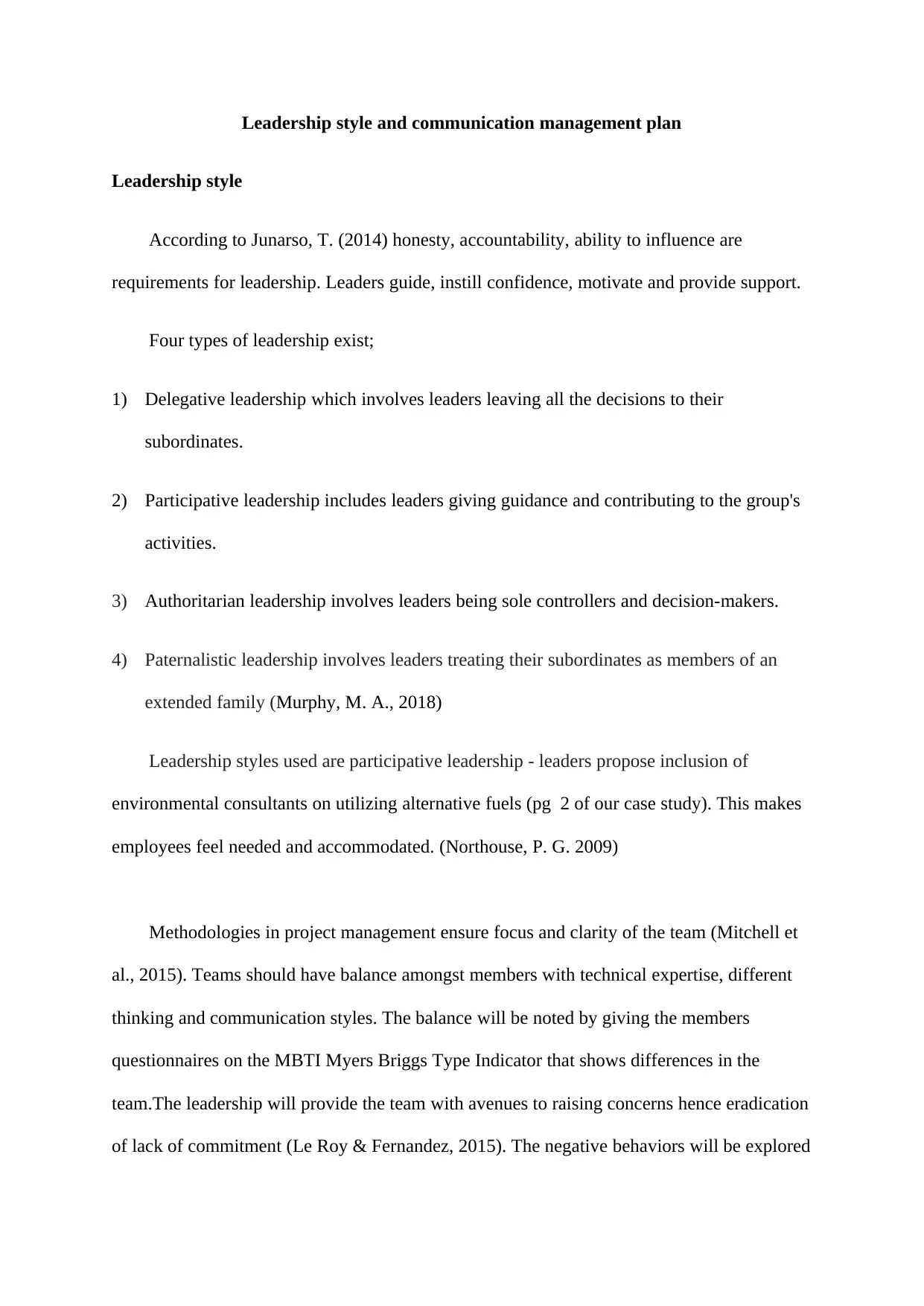
Leadership style and communication management plan
Leadership style
According to Junarso, T. (2014) honesty, accountability, ability to influence are
requirements for leadership. Leaders guide, instill confidence, motivate and provide support.
Four types of leadership exist;
1) Delegative leadership which involves leaders leaving all the decisions to their
subordinates.
2) Participative leadership includes leaders giving guidance and contributing to the group's
activities.
3) Authoritarian leadership involves leaders being sole controllers and decision-makers.
4) Paternalistic leadership involves leaders treating their subordinates as members of an
extended family (Murphy, M. A., 2018)
Leadership styles used are participative leadership - leaders propose inclusion of
environmental consultants on utilizing alternative fuels (pg 2 of our case study). This makes
employees feel needed and accommodated. (Northouse, P. G. 2009)
Methodologies in project management ensure focus and clarity of the team (Mitchell et
al., 2015). Teams should have balance amongst members with technical expertise, different
thinking and communication styles. The balance will be noted by giving the members
questionnaires on the MBTI Myers Briggs Type Indicator that shows differences in the
team.The leadership will provide the team with avenues to raising concerns hence eradication
of lack of commitment (Le Roy & Fernandez, 2015). The negative behaviors will be explored
Leadership style
According to Junarso, T. (2014) honesty, accountability, ability to influence are
requirements for leadership. Leaders guide, instill confidence, motivate and provide support.
Four types of leadership exist;
1) Delegative leadership which involves leaders leaving all the decisions to their
subordinates.
2) Participative leadership includes leaders giving guidance and contributing to the group's
activities.
3) Authoritarian leadership involves leaders being sole controllers and decision-makers.
4) Paternalistic leadership involves leaders treating their subordinates as members of an
extended family (Murphy, M. A., 2018)
Leadership styles used are participative leadership - leaders propose inclusion of
environmental consultants on utilizing alternative fuels (pg 2 of our case study). This makes
employees feel needed and accommodated. (Northouse, P. G. 2009)
Methodologies in project management ensure focus and clarity of the team (Mitchell et
al., 2015). Teams should have balance amongst members with technical expertise, different
thinking and communication styles. The balance will be noted by giving the members
questionnaires on the MBTI Myers Briggs Type Indicator that shows differences in the
team.The leadership will provide the team with avenues to raising concerns hence eradication
of lack of commitment (Le Roy & Fernandez, 2015). The negative behaviors will be explored
Paraphrase This Document
Need a fresh take? Get an instant paraphrase of this document with our AI Paraphraser
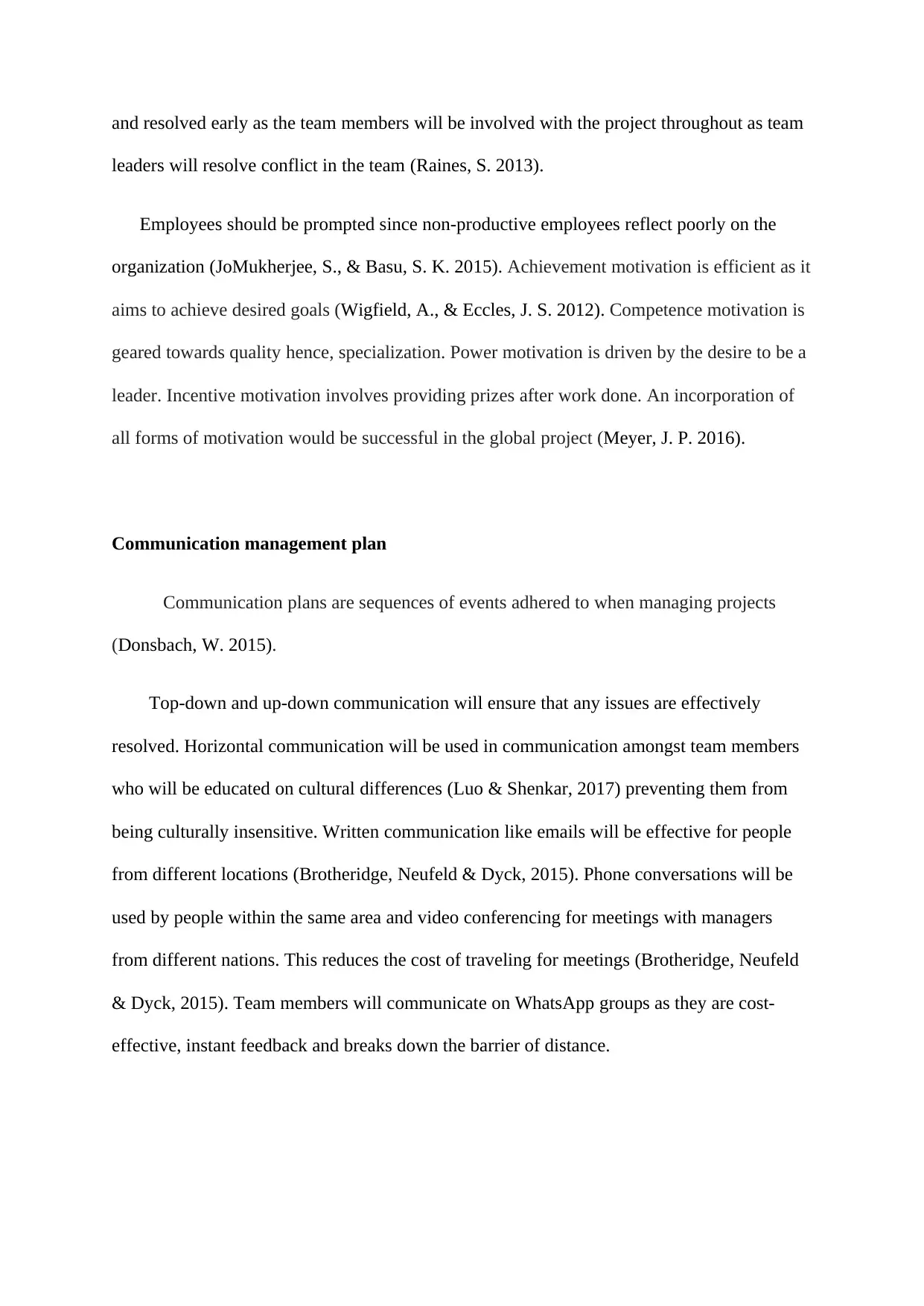
and resolved early as the team members will be involved with the project throughout as team
leaders will resolve conflict in the team (Raines, S. 2013).
Employees should be prompted since non-productive employees reflect poorly on the
organization (JoMukherjee, S., & Basu, S. K. 2015). Achievement motivation is efficient as it
aims to achieve desired goals (Wigfield, A., & Eccles, J. S. 2012). Competence motivation is
geared towards quality hence, specialization. Power motivation is driven by the desire to be a
leader. Incentive motivation involves providing prizes after work done. An incorporation of
all forms of motivation would be successful in the global project (Meyer, J. P. 2016).
Communication management plan
Communication plans are sequences of events adhered to when managing projects
(Donsbach, W. 2015).
Top-down and up-down communication will ensure that any issues are effectively
resolved. Horizontal communication will be used in communication amongst team members
who will be educated on cultural differences (Luo & Shenkar, 2017) preventing them from
being culturally insensitive. Written communication like emails will be effective for people
from different locations (Brotheridge, Neufeld & Dyck, 2015). Phone conversations will be
used by people within the same area and video conferencing for meetings with managers
from different nations. This reduces the cost of traveling for meetings (Brotheridge, Neufeld
& Dyck, 2015). Team members will communicate on WhatsApp groups as they are cost-
effective, instant feedback and breaks down the barrier of distance.
leaders will resolve conflict in the team (Raines, S. 2013).
Employees should be prompted since non-productive employees reflect poorly on the
organization (JoMukherjee, S., & Basu, S. K. 2015). Achievement motivation is efficient as it
aims to achieve desired goals (Wigfield, A., & Eccles, J. S. 2012). Competence motivation is
geared towards quality hence, specialization. Power motivation is driven by the desire to be a
leader. Incentive motivation involves providing prizes after work done. An incorporation of
all forms of motivation would be successful in the global project (Meyer, J. P. 2016).
Communication management plan
Communication plans are sequences of events adhered to when managing projects
(Donsbach, W. 2015).
Top-down and up-down communication will ensure that any issues are effectively
resolved. Horizontal communication will be used in communication amongst team members
who will be educated on cultural differences (Luo & Shenkar, 2017) preventing them from
being culturally insensitive. Written communication like emails will be effective for people
from different locations (Brotheridge, Neufeld & Dyck, 2015). Phone conversations will be
used by people within the same area and video conferencing for meetings with managers
from different nations. This reduces the cost of traveling for meetings (Brotheridge, Neufeld
& Dyck, 2015). Team members will communicate on WhatsApp groups as they are cost-
effective, instant feedback and breaks down the barrier of distance.
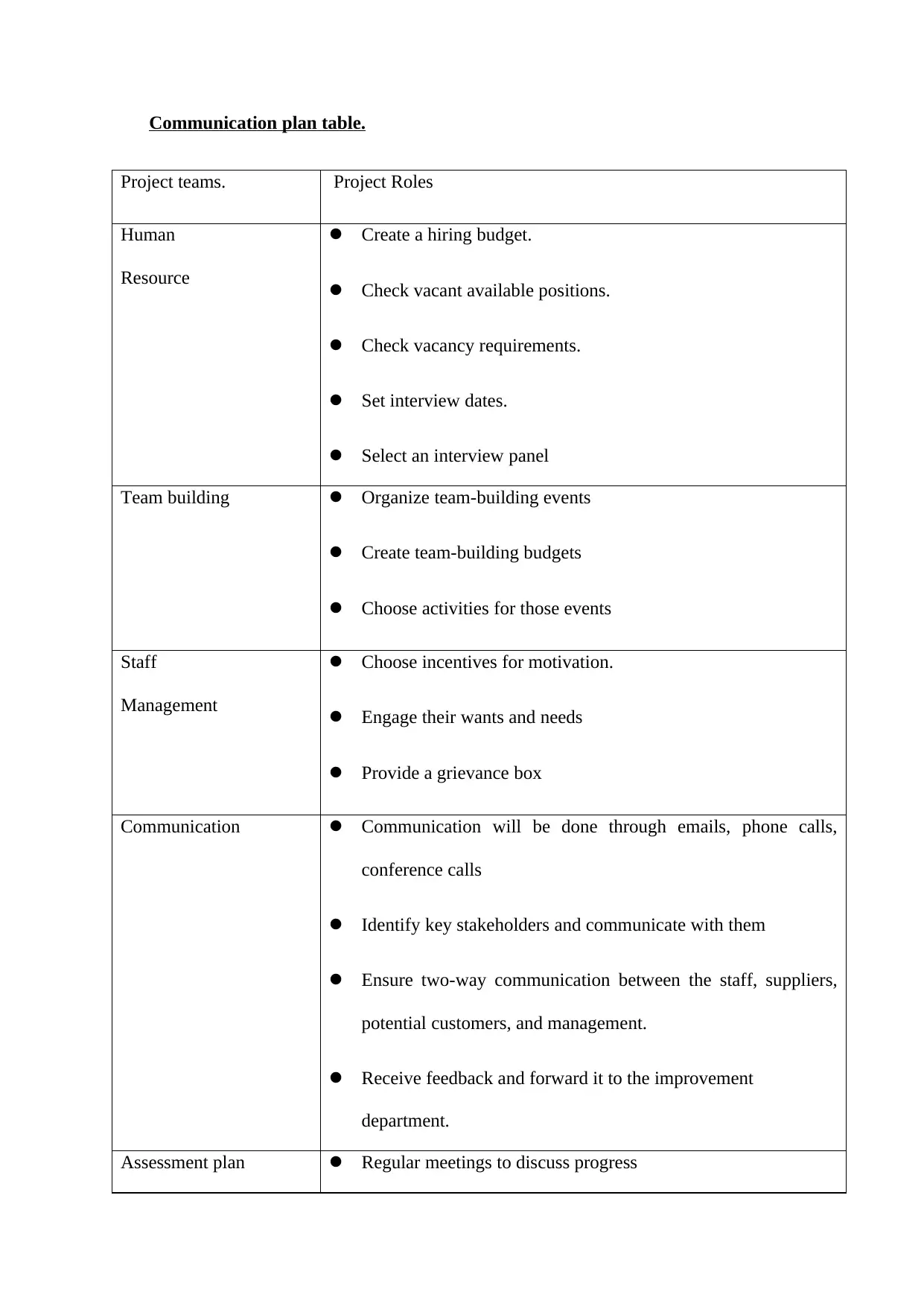
Communication plan table.
Project teams. Project Roles
Human
Resource
Create a hiring budget.
Check vacant available positions.
Check vacancy requirements.
Set interview dates.
Select an interview panel
Team building Organize team-building events
Create team-building budgets
Choose activities for those events
Staff
Management
Choose incentives for motivation.
Engage their wants and needs
Provide a grievance box
Communication Communication will be done through emails, phone calls,
conference calls
Identify key stakeholders and communicate with them
Ensure two-way communication between the staff, suppliers,
potential customers, and management.
Receive feedback and forward it to the improvement
department.
Assessment plan Regular meetings to discuss progress
Project teams. Project Roles
Human
Resource
Create a hiring budget.
Check vacant available positions.
Check vacancy requirements.
Set interview dates.
Select an interview panel
Team building Organize team-building events
Create team-building budgets
Choose activities for those events
Staff
Management
Choose incentives for motivation.
Engage their wants and needs
Provide a grievance box
Communication Communication will be done through emails, phone calls,
conference calls
Identify key stakeholders and communicate with them
Ensure two-way communication between the staff, suppliers,
potential customers, and management.
Receive feedback and forward it to the improvement
department.
Assessment plan Regular meetings to discuss progress
⊘ This is a preview!⊘
Do you want full access?
Subscribe today to unlock all pages.

Trusted by 1+ million students worldwide
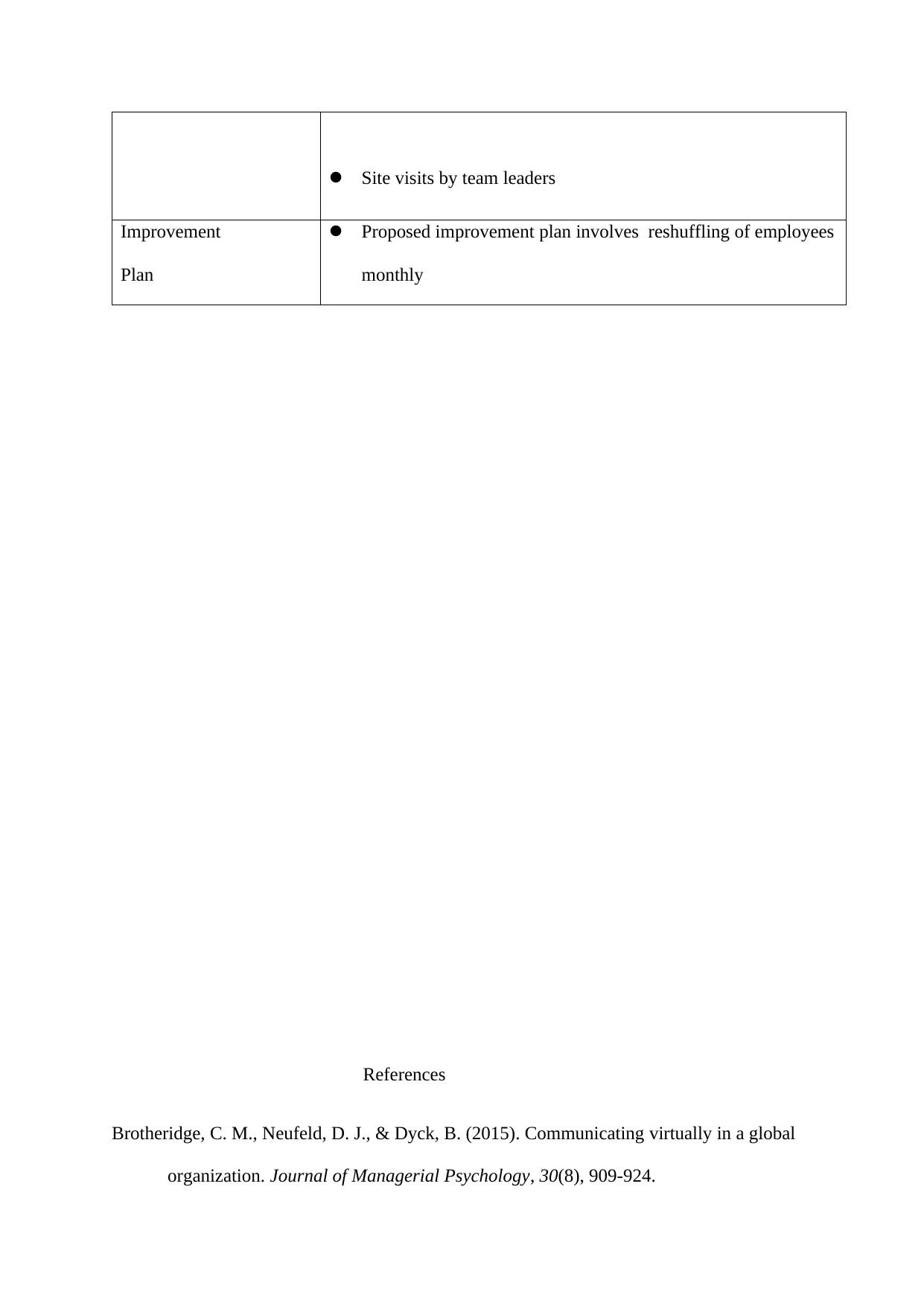
Site visits by team leaders
Improvement
Plan
Proposed improvement plan involves reshuffling of employees
monthly
References
Brotheridge, C. M., Neufeld, D. J., & Dyck, B. (2015). Communicating virtually in a global
organization. Journal of Managerial Psychology, 30(8), 909-924.
Improvement
Plan
Proposed improvement plan involves reshuffling of employees
monthly
References
Brotheridge, C. M., Neufeld, D. J., & Dyck, B. (2015). Communicating virtually in a global
organization. Journal of Managerial Psychology, 30(8), 909-924.
Paraphrase This Document
Need a fresh take? Get an instant paraphrase of this document with our AI Paraphraser
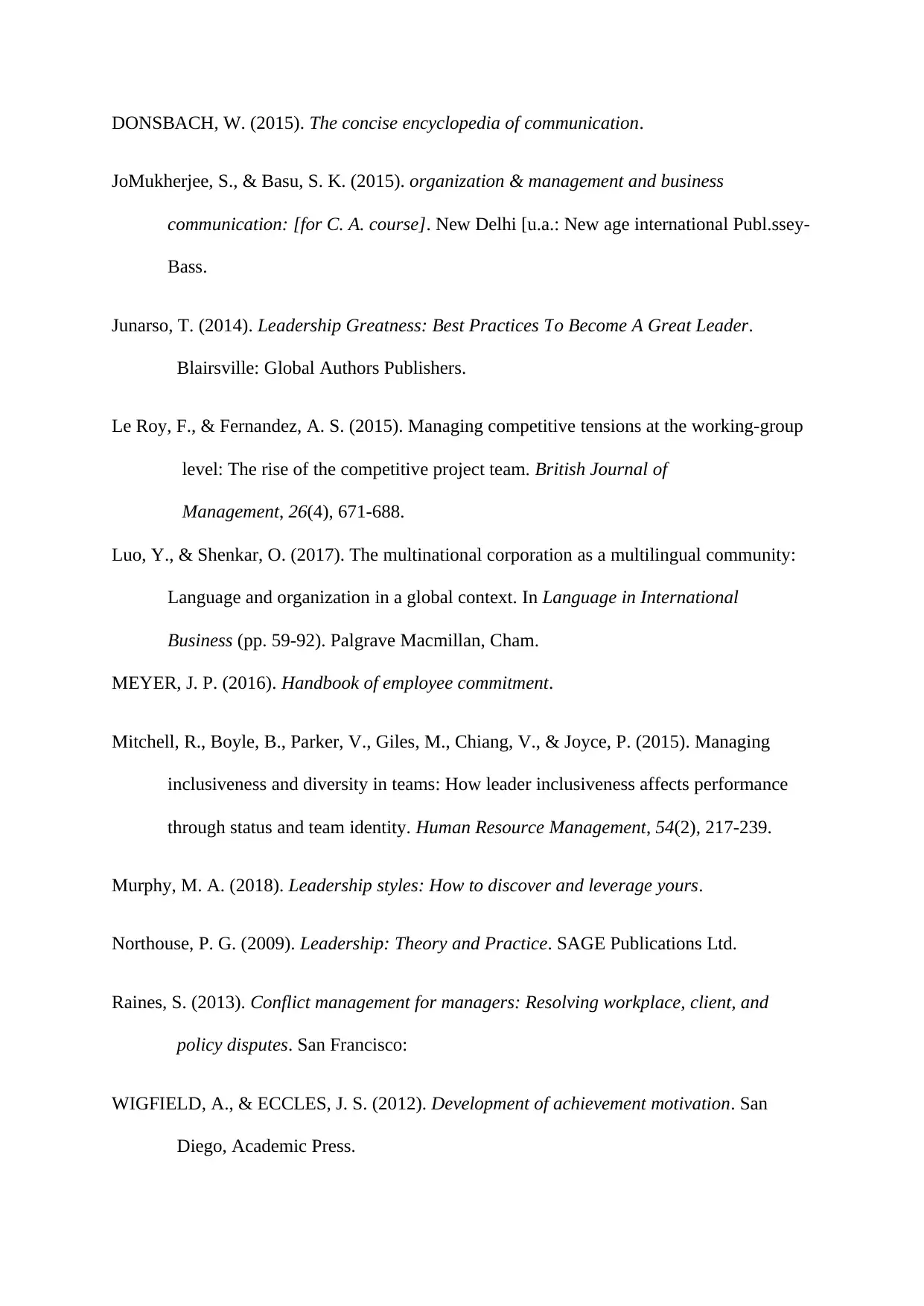
DONSBACH, W. (2015). The concise encyclopedia of communication.
JoMukherjee, S., & Basu, S. K. (2015). organization & management and business
communication: [for C. A. course]. New Delhi [u.a.: New age international Publ.ssey-
Bass.
Junarso, T. (2014). Leadership Greatness: Best Practices To Become A Great Leader.
Blairsville: Global Authors Publishers.
Le Roy, F., & Fernandez, A. S. (2015). Managing competitive tensions at the working‐group
level: The rise of the competitive project team. British Journal of
Management, 26(4), 671-688.
Luo, Y., & Shenkar, O. (2017). The multinational corporation as a multilingual community:
Language and organization in a global context. In Language in International
Business (pp. 59-92). Palgrave Macmillan, Cham.
MEYER, J. P. (2016). Handbook of employee commitment.
Mitchell, R., Boyle, B., Parker, V., Giles, M., Chiang, V., & Joyce, P. (2015). Managing
inclusiveness and diversity in teams: How leader inclusiveness affects performance
through status and team identity. Human Resource Management, 54(2), 217-239.
Murphy, M. A. (2018). Leadership styles: How to discover and leverage yours.
Northouse, P. G. (2009). Leadership: Theory and Practice. SAGE Publications Ltd.
Raines, S. (2013). Conflict management for managers: Resolving workplace, client, and
policy disputes. San Francisco:
WIGFIELD, A., & ECCLES, J. S. (2012). Development of achievement motivation. San
Diego, Academic Press.
JoMukherjee, S., & Basu, S. K. (2015). organization & management and business
communication: [for C. A. course]. New Delhi [u.a.: New age international Publ.ssey-
Bass.
Junarso, T. (2014). Leadership Greatness: Best Practices To Become A Great Leader.
Blairsville: Global Authors Publishers.
Le Roy, F., & Fernandez, A. S. (2015). Managing competitive tensions at the working‐group
level: The rise of the competitive project team. British Journal of
Management, 26(4), 671-688.
Luo, Y., & Shenkar, O. (2017). The multinational corporation as a multilingual community:
Language and organization in a global context. In Language in International
Business (pp. 59-92). Palgrave Macmillan, Cham.
MEYER, J. P. (2016). Handbook of employee commitment.
Mitchell, R., Boyle, B., Parker, V., Giles, M., Chiang, V., & Joyce, P. (2015). Managing
inclusiveness and diversity in teams: How leader inclusiveness affects performance
through status and team identity. Human Resource Management, 54(2), 217-239.
Murphy, M. A. (2018). Leadership styles: How to discover and leverage yours.
Northouse, P. G. (2009). Leadership: Theory and Practice. SAGE Publications Ltd.
Raines, S. (2013). Conflict management for managers: Resolving workplace, client, and
policy disputes. San Francisco:
WIGFIELD, A., & ECCLES, J. S. (2012). Development of achievement motivation. San
Diego, Academic Press.

⊘ This is a preview!⊘
Do you want full access?
Subscribe today to unlock all pages.

Trusted by 1+ million students worldwide
1 out of 6
Related Documents
Your All-in-One AI-Powered Toolkit for Academic Success.
+13062052269
info@desklib.com
Available 24*7 on WhatsApp / Email
![[object Object]](/_next/static/media/star-bottom.7253800d.svg)
Unlock your academic potential
Copyright © 2020–2025 A2Z Services. All Rights Reserved. Developed and managed by ZUCOL.





